Paximadia or Paximathia, Greek biscotti
Paximadia (Paximathia) are twice baked Greek cookies that are very similar to the Italian biscotti. They are a firm dunking cookie but they can also easily be eaten on their own. There are many versions of paximadia; this recipe is full of spices and chopped nuts.
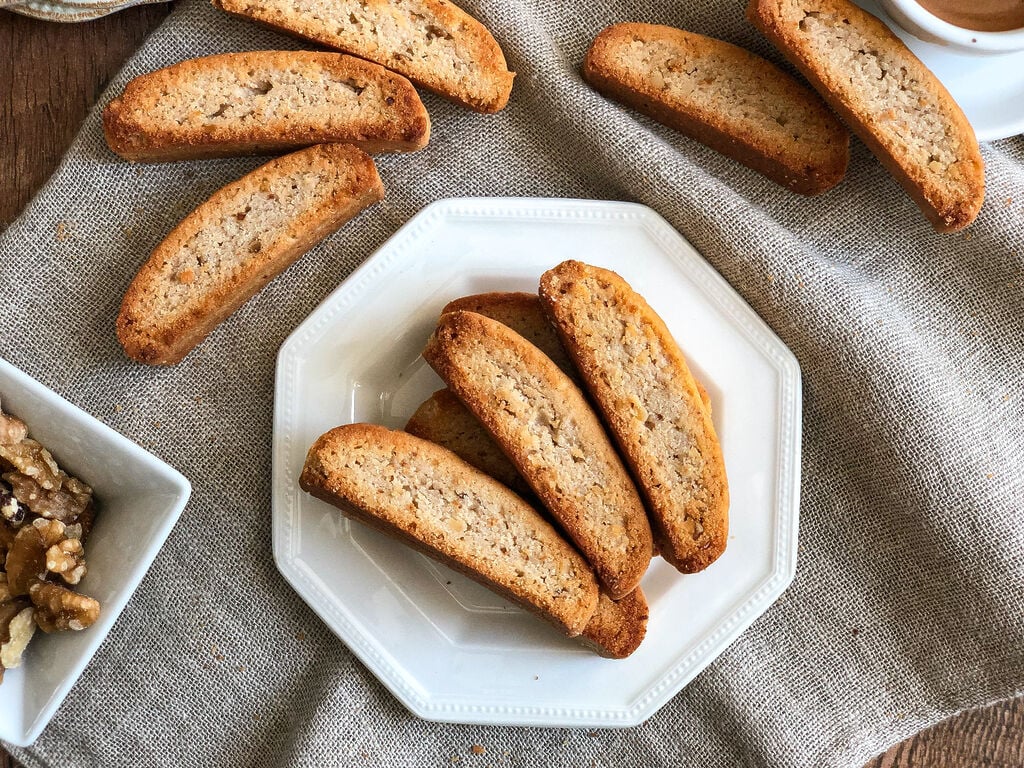
An interesting thing to know is that although Greeks enjoy paximadia all year long, they are the dessert that you will find at gatherings following funerals, and funeral home visitations. In fact, if someone is in mourning and you will be paying your respects at their home, it is common to arrive with a box of paximadia. The reason is that these cookies tend to be less sweet than other desserts, and are not associated with celebrations and joyous occasions, the way that diples and kourabiethes are.
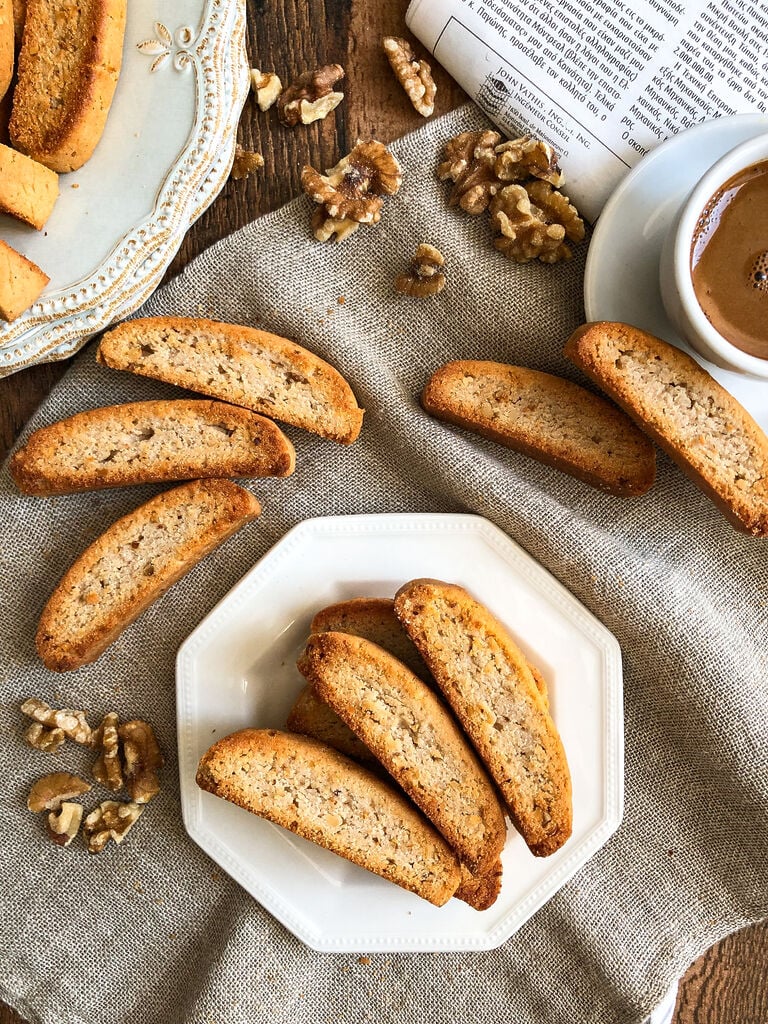
Why this recipe works so well
Have you ever bitten into a biscotti and feared that you broke a tooth? I have! It’s not the bakers fault necessarily – it was probably the recipe. Because biscotti are double baked, the potential for them to dry out and become rock hard is real! Perhaps some people like them this way, because they hold up really well when you dunk them in a hot coffee or a hot chocolate, but I would rather not risk dental work in order to have a sweet treat.
My paximadia recipe, which of course comes from my parents, gives you a biscotti that is firm enough to hold up to being dipped in a warm drink, but at the same time they can be enjoyed just as they are! If you are planning on gifting some of these cookies, they hold up to being shipped too, so long as they are packaged properly.
I have described the steps to take in this recipe with as much detail as possible in order to make sure that you have great success with the recipe. The photos and video clips should help as well.
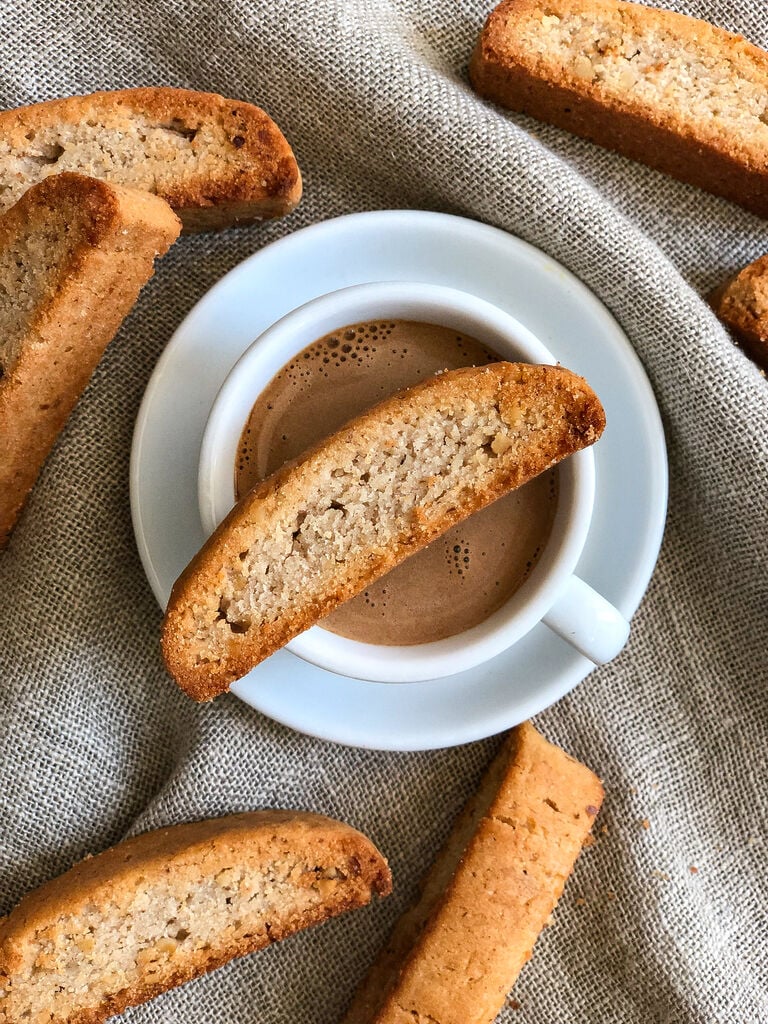
Key ingredients
Sugar The paximadia are sweetened with white, granulated sugar. This is a mild flavoured sweetener that is used in many desserts.
Vegetable oil I like to use vegetable oil in these Greek biscotti because the flavour is not overpowering and it gives the dough a nice, light texture.
Milk I have made these paximadia with different types of dairy milk – lactose-free, skim milk, full fat…they all work equally well, so simply use what you have available.
Eggs I use large eggs in this recipe. In fact, in all recipes if eggs are used, assumed that they are large, unless otherwise specified.
Baking powder This is the leavening agent used to help the paximadia rise just enough to make the perfect Greek biscotti.
Combined crushed nuts I typically use a combination of almonds and walnuts in this recipe that I crush using a food processor.
Ground cinnamon I love the flavour of cinnamon in these simple Greek cookies.
All purpose flour Also called regular or plain flour, this is a wheat flour that is very commonly used in baking because it is so versatile.
How to make
Step 1
Preheat oven to 350 degrees Fahrenheit.
Step 2
In the bowl of your stand mixer combine the sugar and oil and beat for about 5 minutes at medium speed.
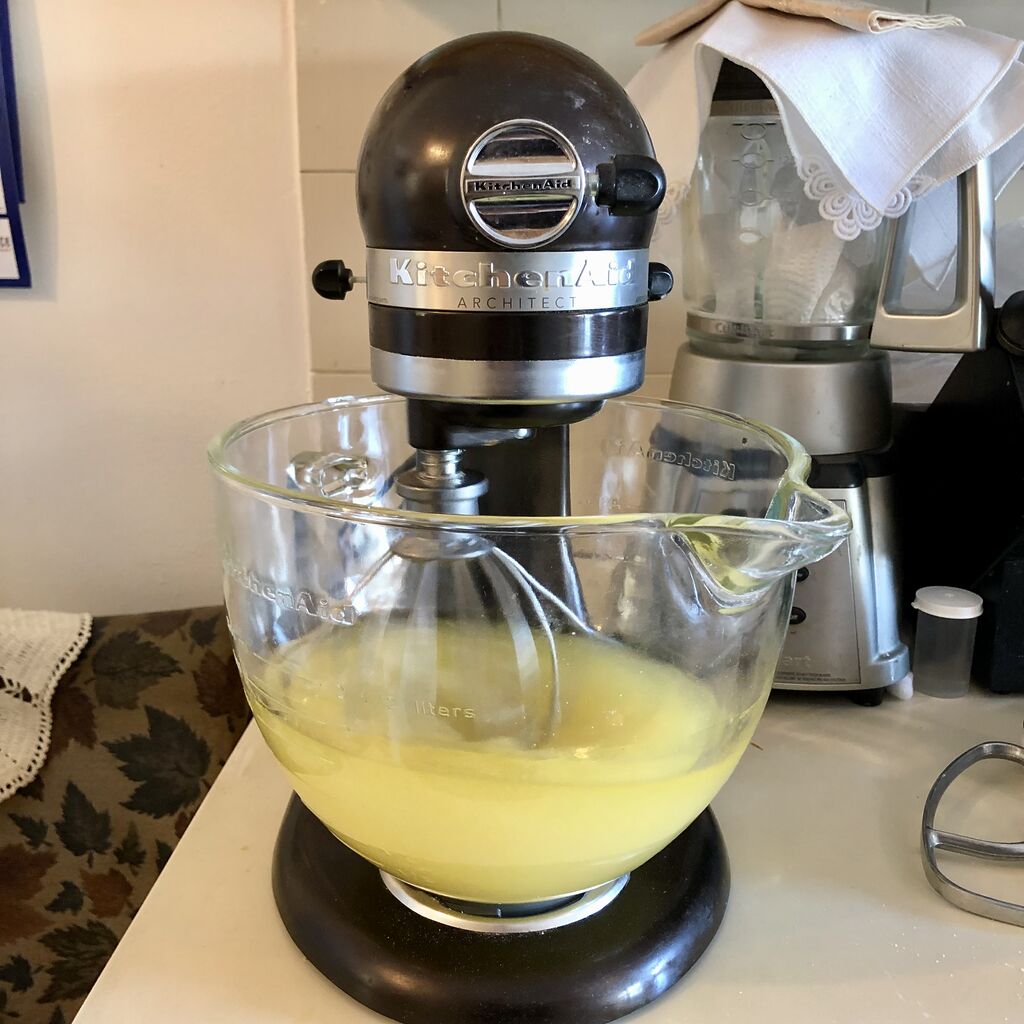
Step 3
Next add the milk and the eggs, one at a time. Beat for another 5 minutes. Next add your mixed nuts and mix until just combined.
Step 4
In a small bowl combine the baking powder and cinnamon with a ¼ cup of your already measured sifted flour. Whisk to combine and then add to the bowl of your mixer.
Step 5
With the mixer speed set to low, begin adding the rest of the flour, about a ½ cup at a time. You may not need all of the flour. You will know that you have added enough flour when the dough starts pulling away from the sides of the mixing bowl. At this time, you will likely have to transfer the dough to a larger mixing bowl, to finish kneading by hand.
Step 6
Add 1 teaspoon of oil to bottom of a large bowl.. Add your dough and keep kneading. The dough should feel a little dense and tough, to prevent it from spreading too much while baking. At the same time it should feel soft and it will be a bit sticky. See video here.
Step 7
Separate out your dough into 425 grams portions. Dust your counter with a bit of flour and form the dough into logs which are 2-2 ¾ inches wide, and place on a parchment lined baking tray. The length of the log should be the width of the baking pan. Flatten a little bit using your hands.
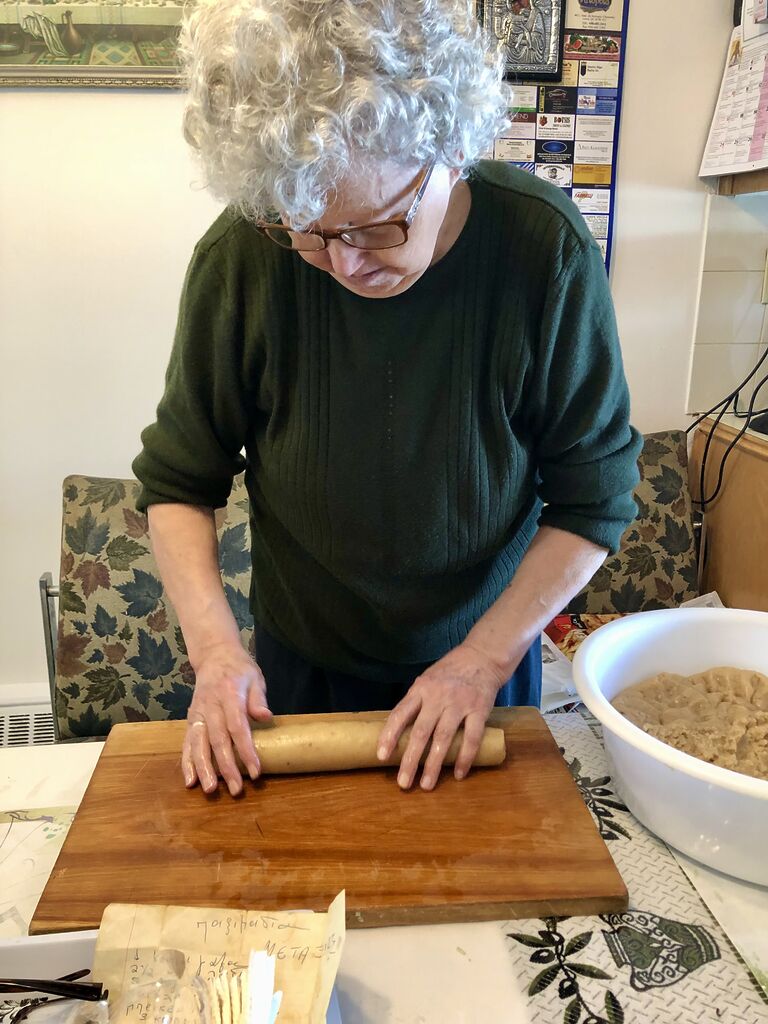
Step 8
Lightly score the dough horizontally about 1/3 of the way deep and about 3/4-1 inch apart.
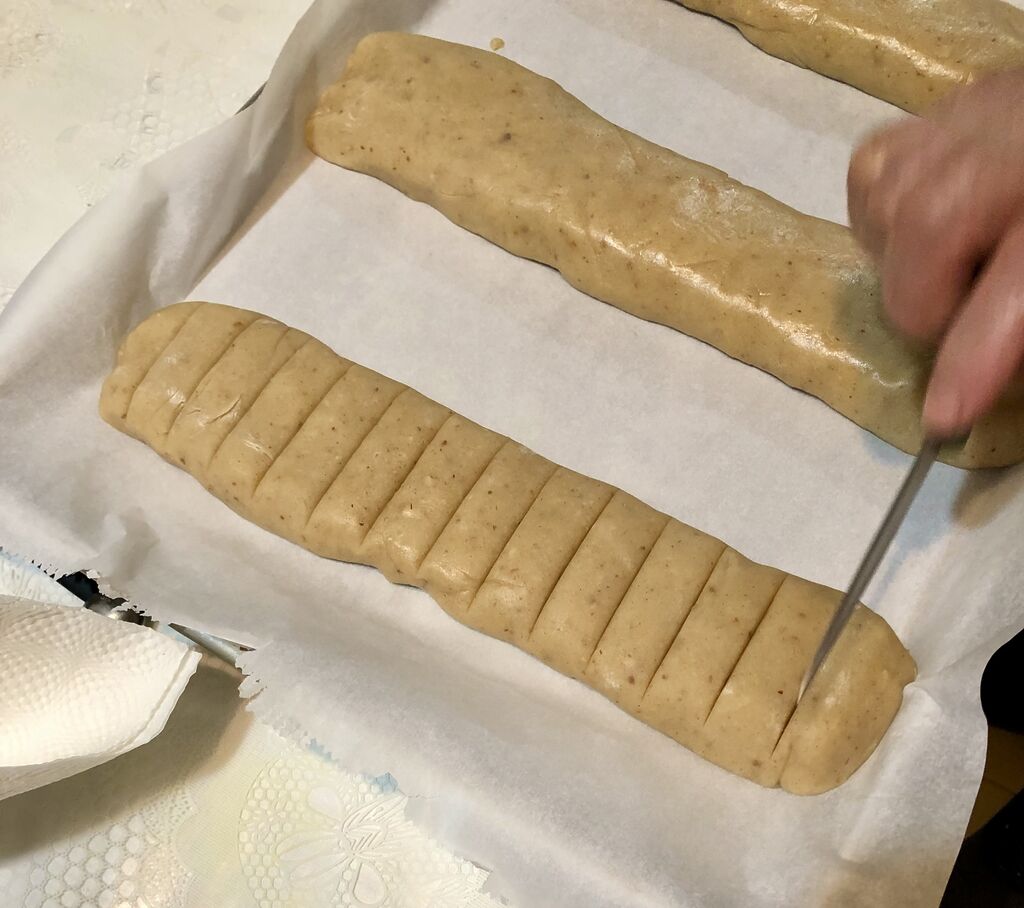
Step 9
Bake in middle rack of your oven for 25-30 minutes. Rotate your pan halfway through the baking time.
Step 10
Remove from oven, and while still hot, and still in pan, cut your dough (where it had been scored) all the way through. Flip each piece on its side. Broil for 1-2 minutes per side; watch them carefully so that they don’ t burn.
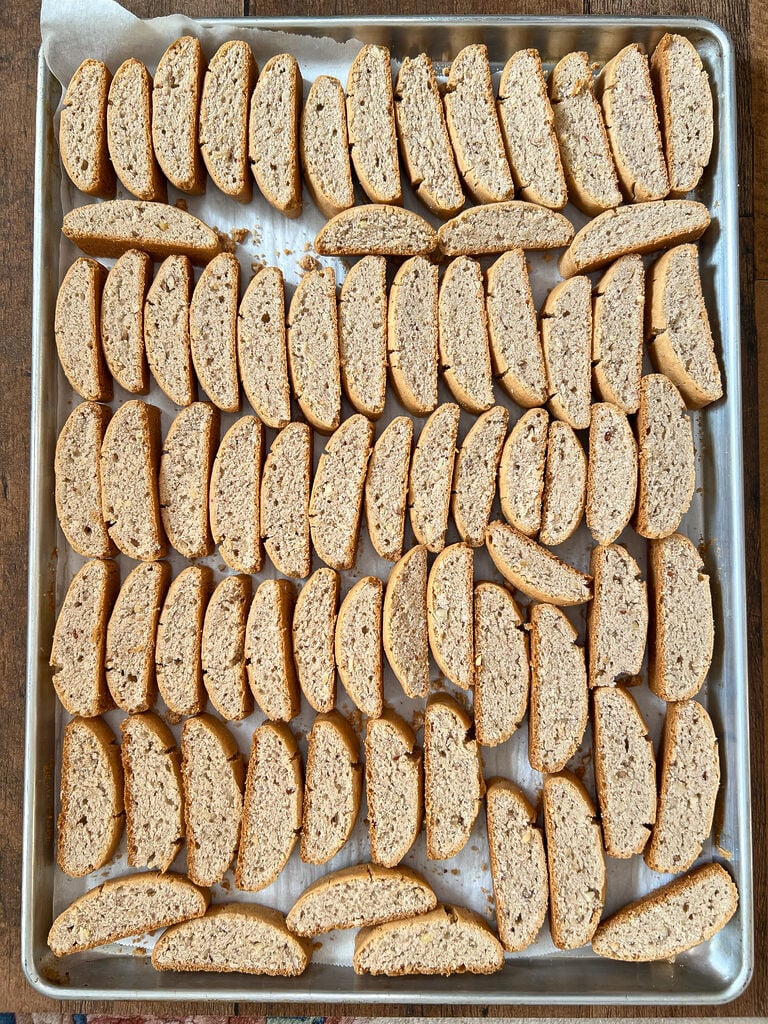
Baking tips and helpful hints
- If you want softer paximadia consider baking them for less than the recommended time. You can try an initial baking time of 20 minutes before you slice them into individual cookies.
- When cutting the cookies use a sharp straight edged knife. This will help prevent the cookies from crumbling apart when they are being cut.
- Watch your cookies carefully, especially when you are baking them for the second time after they are sliced. They can go from perfect to too hard or burnt quickly.
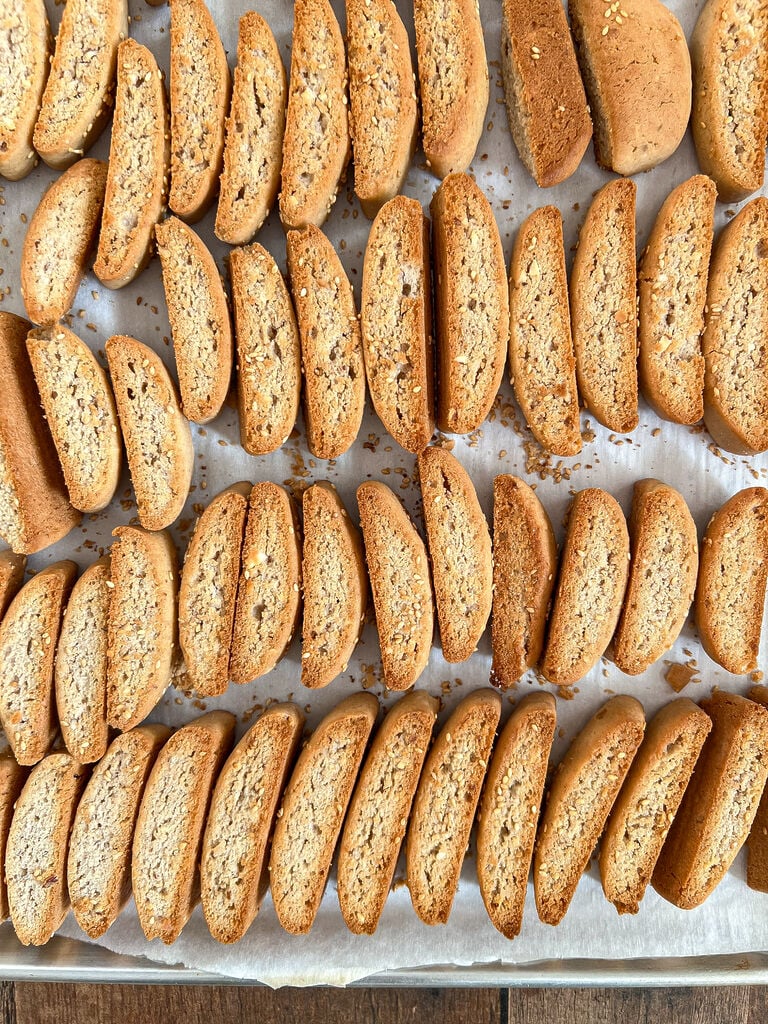
Recipe substitutions
Mix up the mixed nuts
Although I like to use a combination of walnuts and almonds, you can definitely use only one or the other. Otherwise, you can also use other nuts you enjoy – hazelnuts would be great as would brazil nuts or pecans. Let you imagination (and what is available in your pantry) be your guide!
Use olive oil instead
If you want to make these Greek biscotti even more Greek, swap the vegetable oil for olive oil, or use half vegetable oil, half olive oil. This will not change the texture of the cookie, but it will change the colour, and the flavour. It will also change the cost as olive oil is typically more expensive than vegetable oil.
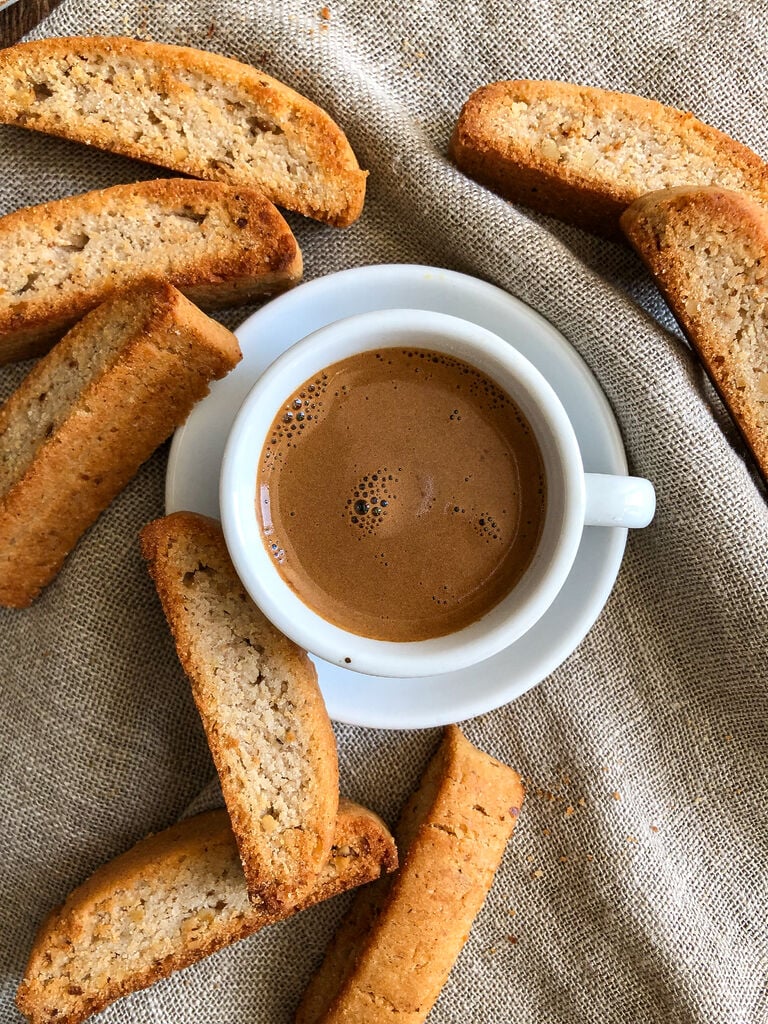
Frequently asked questions
Are paximadia always sweet?
No, actually there are two types of Greek paximadia (paximathia), sweet ones like this recipe and savoury paximadia that are known as rusks in English. This latter type is a form of bread that is baked to dry it out. This is what you use to make the famous Cretan dakos. I also love to take the savoury paximadia, break it up into pieces the size of croutons, and add it to my Greek village salad. So good!
What does the word paximadia mean?
Apparently a Byzantine monk named Paximus perfected the art of drying out bread to make rusks, and the result was that they were named after him! This was a really great discovery because by drying out bread, it was able to keep longer before developing mold.
How to store
Paximadia keep in a well covered container for up to two weeks at room temperature. If you would like to keep them fresh longer you can either keep them in the refrigerator, or freeze them. If freezing, place them in a single layer on a cookie tray, freeze, and then transfer to a freezer bag or freezer safe container.
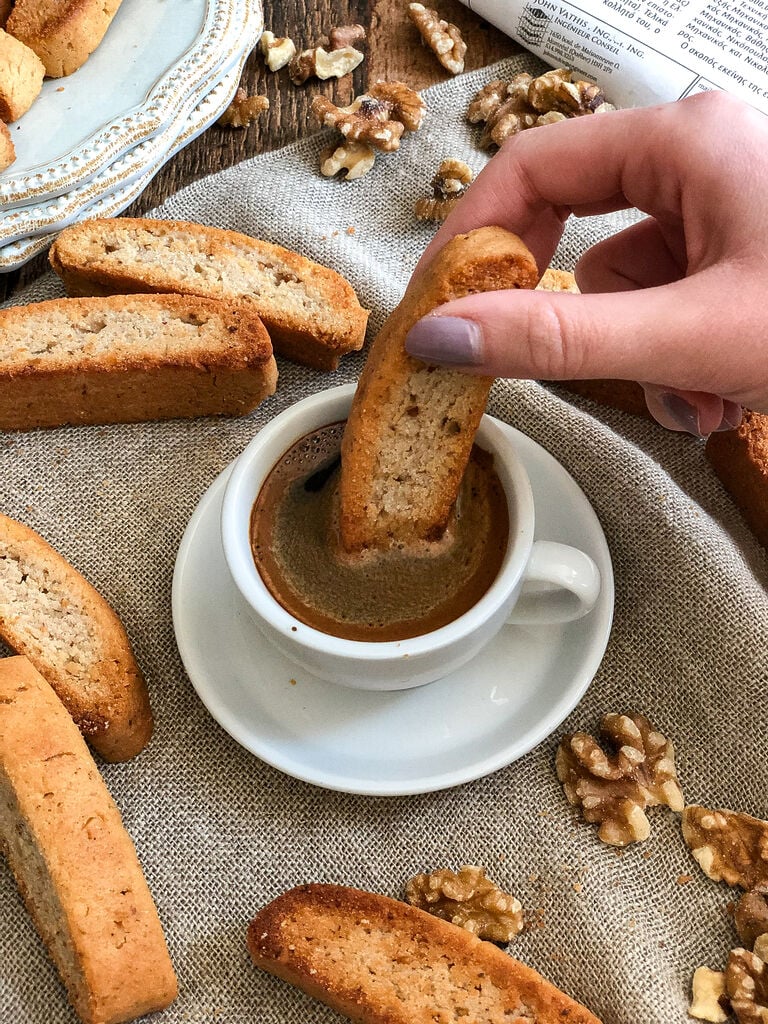
Related recipes
Italian biscotti recipe Simple and delicious biscotti with chocolate covered almonds
Easy Italian chocolate biscotti recipe A double does of chocolate in these Italian dunking cookies!
Easy 5 ingredient Greek koulourakia My parents wonderful, and wonderfully simple, Greek koulourakia cookies.
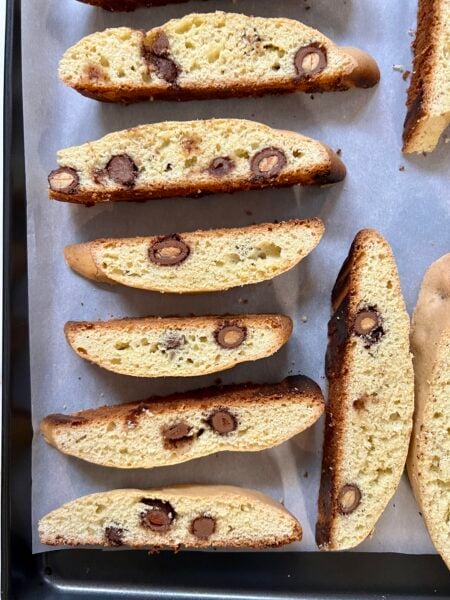
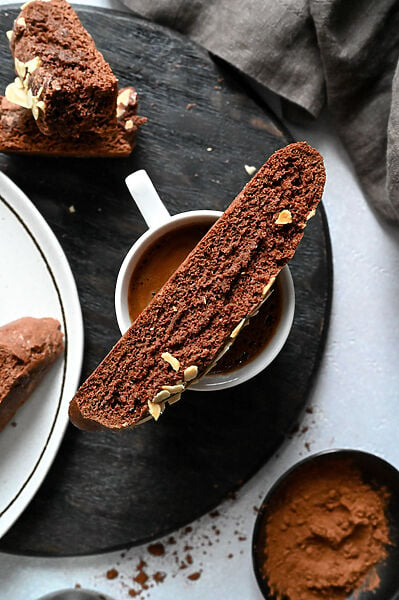
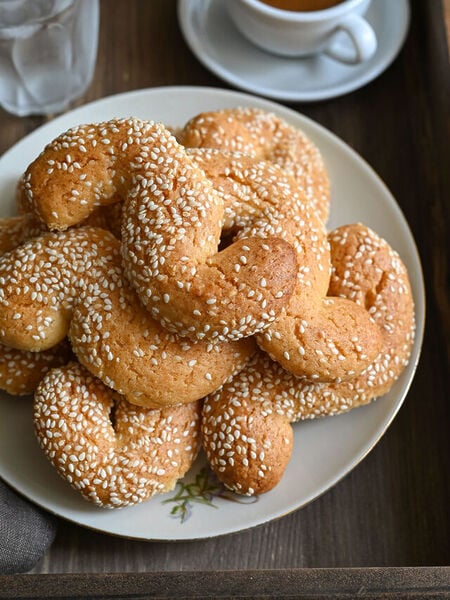
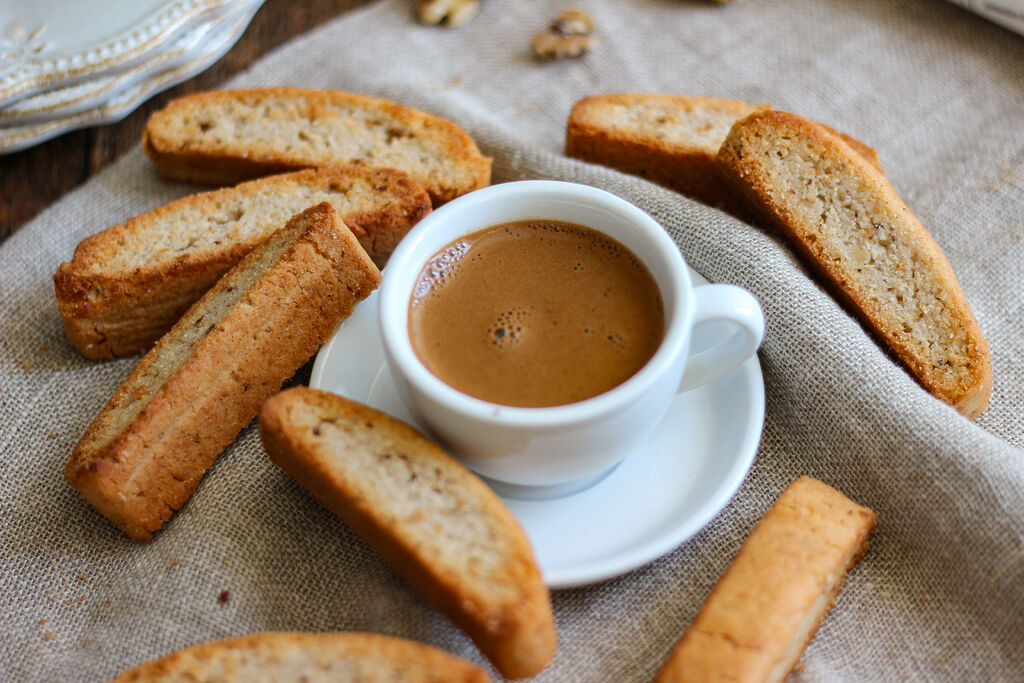
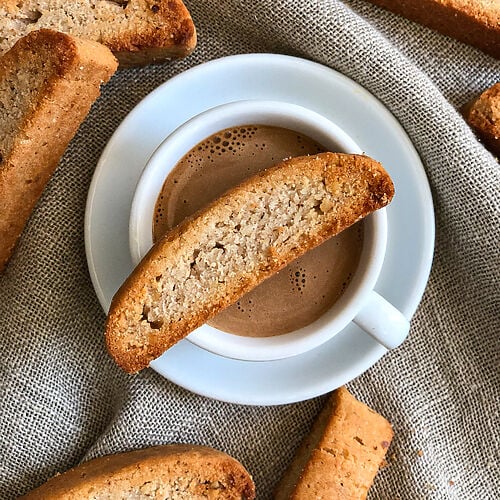
Paximadia, Greek biscotti
Equipment
- 1 Stand mixer optional, but helpful
- 1 flour sifter or fine sieve
- 1 small bowl
- 1 Large bowl
- 1 sharp knife for scoring dough
Ingredients
- 3 cups sugar
- 3 ⅓ cups vegetable oil or other light flavoured oil
- 1 ⅓ cups milk we used 2% milk
- 5 large eggs
- 4 tbsp baking powder
- 2 ½ tsp ground cinnamon
- 1 ½ cups combined crushed walnuts/almonds
- 10 cups sifted all purpose flour
- 1 tsp vegetable oil
Instructions
- Preheat oven to 350 °F
- In the bowl of your stand mixer combine the sugar and oil and beat for about 5 minutes at medium speed.3 ⅓ cups vegetable oil, 3 cups sugar
- Next add the milk and the eggs, one at a time. Beat for another 5 minutes. Next add your mixed nuts and mix until just combined.1 ⅓ cups milk, 5 large eggs, 1 ½ cups combined crushed walnuts/almonds
- In a small bowl combine the baking powder and cinnamon with a ¼ cup of your already measured sifted flour. Whisk to combine and then add to the bowl of your mixer.4 tbsp baking powder, 10 cups sifted all purpose flour, 2 ½ tsp ground cinnamon
- With the mixer speed set to low, begin adding the rest of the flour, about a ½ cup at a time. You may not need all of the flour. You will know that you have added enough flour when the dough starts pulling away from the sides of the mixing bowl. At this time, you will likely have to transfer the dough to a larger mixing bowl, to finish kneading by hand.
- Add 1 teaspoon of oil to bottom of a large bowl.. Add your dough and keep kneading. The dough should feel a little dense and tough, to prevent it from spreading too much while baking. At the same time it should feel soft and it will be sticky. See video here.1 tsp vegetable oil
- Let the dough rest for about 10 minutes so it can firm up.
- Separate out your dough into 425 grams portions. Dust your counter with a bit of flour and form the dough into logs which are 2-2 ¾ inches wide, and place on a parchment lined baking tray. The length of the log should be the width of the baking pan. Flatten a little bit using your hands. See video here.
- Lightly score the dough horizontally about 1/3 of the way deep and about 3/4-1 inch apart. See video here.
- Bake in middle rack of your oven for 25-30 minutes. Rotate your pan halfway through the baking time.
- Remove from oven, and while still hot, and still in pan, cut your dough (where it had been scored) all the way through. Flip each piece on its side. Broil for 1-2 minutes per side; watch them carefully so that they don' t burn. See video here.
- Enjoy!
